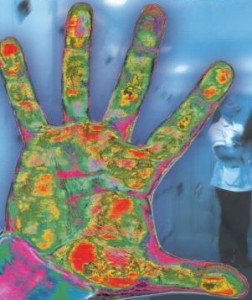5% of hospital patients develop an infection. And the majority of those infections are acquired from the hands of Health Care Providers.
Medicare pays 40% of the nation’s hospital bills. (This, in and of itself, is an argument for a single payer system – one single payer already pays 40% of hospital bills. And it’s the Government.) However, Medicare does not reimburse hospitals for their mistakes. It shouldn’t. If I borrow your car, and run out of gas, it’s my fault, not yours. Note that this is an example of the government doing something right.
Because of this policy decision, medical accidents went from being a source of hospital revenue to a massive financial drain. Medical institutions were forced into the business of disease prevention, at least once people were in their care.
According to the Committee to Reduce Infection Deaths statistics, (PDF) hospital acquired infections kill more people in America than AIDS, Breast Cancer and Auto Accidents combined. What is worse is that 5% of the patients in hospitals acquire infections in the hospital, and the vast majority of the patients that acquire such infections in hospitals get them from the hands of health care providers.
More details after the click.
in Moving Through Hospitals: Designing Handwashing and Designing Handwashing Part 2: Diverse Nudges in a Hospital, by Rachel Lehrer, a designer, dancer, and student at the MFA in Transdisciplinary Design at Parsons, and excerpted below.
In October, 2008, Medicare—the United States’ government program that pays 40% of the nation’s hospital bills—decided to stop covering hospital failures. This meant that a litany of preventable mistakes, including treatments resulting from surgical errors, patient accidents and infections, were now the financial responsibility of the hospital. As a result, medical accidents went from being a source of hospital revenue to a massive financial drain. The good news is that medical institutions were finally forced into the business of disease prevention, at least once people were in their care.
What can be done to prevent costly medical mistakes? The hospital reform with the greatest potential is also the easiest to implement, at least in theory. According to the Committee to Reduce Infection Deaths statistics, hospital acquired infections kill more people in America than AIDS, breast cancer and auto accidents combined. Furthermore, the vast majority of the patients that acquire such infections in hospitals—and more than 5 percent of patients do—get them from the hands of health care providers. Thankfully, hospitals have become increasingly concerned with hand hygiene. The dirty hands of doctors and nurses aren’t just gross—they are an extremely expensive and potentially fatal act of carelessness. Hospital staffers, in order to follow protocol, need to wash their hands hundreds of times a day. Their failure to follow protocol perfectly is their personal responsibility but non-compliance on such a broad scale is also a failure of the medical system that creates the rules and environment that lead non-compliance.
The medical industry’s acknowledgment of hand hygiene as a systemic problem has led to the establishment and growing influence of Infection Control and Prevention Units. For Infection Control and Prevention, solving handwashing takes the form of cheeky posters of doctors reminding everyone to wash their hands, developing inane training videos demonstrating how to properly wash your hands and implementing incentive programs where health care workers reward each other with certificates when they observe a co-workers consistent compliance. In the hospital where I have focused my research, these certificates were returned unused.
One increasingly popular but misguided program has to been to implement paternalistic monitoring of nurses and other providers, who are forced to undergo increasing levels of surveillance. Whether it is video monitoring systems borrowed from meat manufacturing plants or sensor systems that read the alcohol content on hands, staff are cajoled into changing their behavior by receiving real time feedback combined with their fear that their personal compliance level is now public knowledge. There is no carrot—there is only a stick.
via Moving Through Hospitals: Designing Handwashing – Core77.
Rachel Lehrer is a designer, dancer and student of the MFA Transdisciplinary Design program at Parsons. Her work centers around the question: how can we optimize our body’s intelligence to improve performance? Through years of movement, choreographic and improvisational practice she’s gained expertise in physical learning, tacit knowledge, movement analysis, movement scripting and conducting deeply felt research that vacillates between being highly structured and improvisatory. Rachel also likes writing, rehearsing and making videos about people, ideas and designs that matter to her. Follow her on twitter @rachielehrer. Core77.
The Committee to Reduce Infection Deaths was founded by Betsy McCaughey, Ph.D. in 2004. McCaughey was Lt. Governor of New York from 1995 thru 1998, during Gov. Pataki’s first term. Lt. Gov. McCaughey was not contacted for this post.
